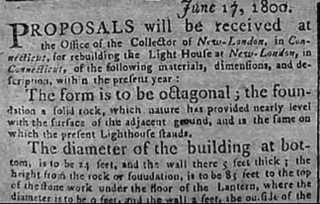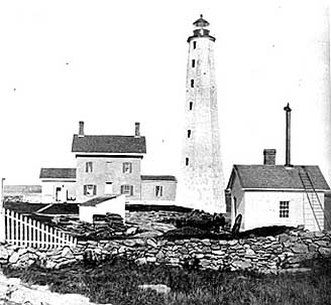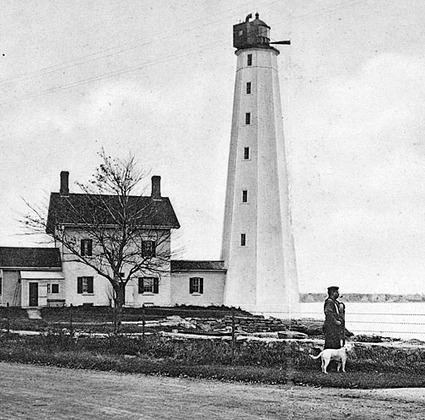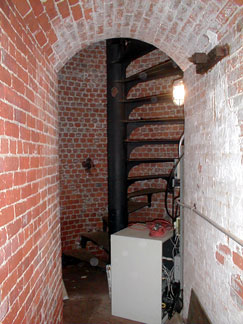History of New London Harbor Lighthouse, New London, Connecticut
More information: Front page / Photos / Bibliography / Cruises / Postcards
© Jeremy D'Entremont. Do not reproduce any part of this website without permission of the author.
New London, founded in 1646 by John Winthrop, Jr., became an important port in colonial America because of its protected harbor at the mouth of the Thames River.

In 1834, over 30 ships and 900 men from New London were employed
in whaling. By the middle of the 1800s, New London was America's
third leading whaling port, behind New Bedford and Nantucket.
An early beacon of some kind was reportedly erected around
1750 at the harbor's entrance, but it soon became apparent that
a more permanent lighthouse was needed.
A 64-foot stone tower with a wooden lantern was erected at the west side of the harbor entrance in 1761, paid for by money raised by selling lottery tickets.
Left: Robert Dennis Collection of Stereoscopic Views, Photography Collection, Miriam & Ira D. Wallach Division of Art, Prints & Photographs, The New York Public Library.
A 64-foot stone tower with a wooden lantern was erected at the west side of the harbor entrance in 1761, paid for by money raised by selling lottery tickets.
Left: Robert Dennis Collection of Stereoscopic Views, Photography Collection, Miriam & Ira D. Wallach Division of Art, Prints & Photographs, The New York Public Library.
The land for the lighthouse was bought from the merchant Nathaniel Shaw, Jr.

New London Harbor Light was the fourth lighthouse in North America and the first on Long Island Sound. A tax on local shipping helped pay for the upkeep of the tower.
The lighthouse made it through the American Revolution unscathed, helping to guide American privateers into New London Harbor. In 1791, President George Washington signed legislation authorizing the expenditure of $360 quarterly to supply New London Harbor Light's six lamps with spermaceti oil.
The lighthouse developed a large crack by 1799, and there were numerous complaints that the light was difficult to distinguish from neighboring homes.
The lighthouse made it through the American Revolution unscathed, helping to guide American privateers into New London Harbor. In 1791, President George Washington signed legislation authorizing the expenditure of $360 quarterly to supply New London Harbor Light's six lamps with spermaceti oil.
The lighthouse developed a large crack by 1799, and there were numerous complaints that the light was difficult to distinguish from neighboring homes.
In 1801 a new 89-foot stone lighthouse with a cast-iron lantern was completed by Abisha Woodward of New London.

U.S. Coast Guard photo
An oil house and cistern building were also built at a total cost of $15,547. The
handsome octagonal brownstone tower still stands and is the oldest
existing lighthouse in Connecticut.
An 1802 letter recommended that the salary of the keeper be raised from $200 yearly, at which it had remained for many years, because, "the Lighthouse has been made much higher, the light augmented, the machinery of the eclipser to be kept in order..."
New London Harbor Light was one of the earliest American lighthouses with a flashing light. The revolving eclipser gave it a distinct characteristic so it couldn't be confused with the lights of nearby houses.
New London Harbor Light was extinguished during the War of 1812 at the request of Commodore Decatur. With the militia nearby the British decided not to raid the lighthouse, but they did raid Little Gull Island Light farther out in Fishers Island Sound.
A new keeper's dwelling was built in 1818 for $1,200. The present keeper's house was built in 1863 and was enlarged in 1900.
An 1802 letter recommended that the salary of the keeper be raised from $200 yearly, at which it had remained for many years, because, "the Lighthouse has been made much higher, the light augmented, the machinery of the eclipser to be kept in order..."
New London Harbor Light was one of the earliest American lighthouses with a flashing light. The revolving eclipser gave it a distinct characteristic so it couldn't be confused with the lights of nearby houses.
New London Harbor Light was extinguished during the War of 1812 at the request of Commodore Decatur. With the militia nearby the British decided not to raid the lighthouse, but they did raid Little Gull Island Light farther out in Fishers Island Sound.
A new keeper's dwelling was built in 1818 for $1,200. The present keeper's house was built in 1863 and was enlarged in 1900.
An 1838 report by Lieutenant George M. Bache described New London Harbor Light:

It is situated on a rocky point to the westward of the
entrance to the river Thames, and is two miles from the town
of New London; it is of great importance as a leading light for
vessels going in and out of the harbor of New London, which,
on account of its position and security, is much resorted to
during the heavy gales of winter.
The tower is a substantial building of freestone, smooth
hammered, and laid in courses; it is 80 feet in height, and is
ascended by an interior stairway of wood... The lighting
apparatus consists of 11 lamps, with parabolic reflectors, disposed
around two horizontal tables... This apparatus was furnished
in 1834, and is now in very good order... The light-keeper covers
the ordinary wicks with small pieces of cotton cloth, which he
thinks increases the consumption of oil, and causes the lamps
to give a brighter light.
The lighthouse's lamps and reflectors were replaced by a fourth order Fresnel lens in 1857, and the lens remains in use today.
Many experiments with fog signals were carried out at New London Harbor Light. A second-class Daboll trumpet was installed in 1874, operated by a hot-air engine. In 1883 a new first-class fog signal was installed, and in 1896 new engines and air compressors were added.
In 1904 a new fog siren provoked complaints from the local summer residents. One man exclaimed, "How about that horrible shrieking and groaning siren that has been stuck up on top of the lighthouse here? Unless something is done pretty soon, this will be the best field of practice for a specialist of nervous disease that I know of."
The mayor of New London was among 75 citizens who signed a petition for the removal of the signal. A compromise was reached when a less objectionable trumpet replaced the siren. In 1911 the fog signal was relocated to the New London Ledge Light.
The lighthouse's lamps and reflectors were replaced by a fourth order Fresnel lens in 1857, and the lens remains in use today.
Many experiments with fog signals were carried out at New London Harbor Light. A second-class Daboll trumpet was installed in 1874, operated by a hot-air engine. In 1883 a new first-class fog signal was installed, and in 1896 new engines and air compressors were added.
In 1904 a new fog siren provoked complaints from the local summer residents. One man exclaimed, "How about that horrible shrieking and groaning siren that has been stuck up on top of the lighthouse here? Unless something is done pretty soon, this will be the best field of practice for a specialist of nervous disease that I know of."
The mayor of New London was among 75 citizens who signed a petition for the removal of the signal. A compromise was reached when a less objectionable trumpet replaced the siren. In 1911 the fog signal was relocated to the New London Ledge Light.
A 1904 article by Arthur Hewitt described a visit of the lighthouse tender Larkspur to New London Harbor Light while the fog signal was still located there:

The keeper [Charles B. Field], a Swede, was a very
intelligent man; curious to relate, he was a connoisseur in violins,
about which he told me a great deal and tried to tell me more;
but I wanted to know of other things -- the sea and ships.
When we were in the tower talking of fog, he told me how one night, when he was operating the horn, and 'the fog was so thick yer could have cut it with a knife and it fairly stuck in yer throat,' suddenly the sound seemed to strike something and reverberate with a strange echo against the lighthouse.
Instinct told him that this was caused by the sails of some ship quite near by and in immediate danger of running on the rocks. He shouted a warning to the invisible ship, and between the blasts of the horn surely enough there came back an answer. He had altered the vessel's course just in time.
(Left: The keeper seen in this photo from the early 1900s is probably Charles B. Field.)
When we were in the tower talking of fog, he told me how one night, when he was operating the horn, and 'the fog was so thick yer could have cut it with a knife and it fairly stuck in yer throat,' suddenly the sound seemed to strike something and reverberate with a strange echo against the lighthouse.
Instinct told him that this was caused by the sails of some ship quite near by and in immediate danger of running on the rocks. He shouted a warning to the invisible ship, and between the blasts of the horn surely enough there came back an answer. He had altered the vessel's course just in time.
(Left: The keeper seen in this photo from the early 1900s is probably Charles B. Field.)
_In April 2005, it was announced that ownership of the lighthouse would be transferred to the New London Maritime Society under the provisions of the National Historic Lighthouse Preservation Act of 2000. The society also operates the Custom House Maritime Museum, and promotes the maritime history of New London through its collections, library, archives, museum exhibits, and educational programs.
The New London Maritime Society's ownership of the lighthouse became official in 2009, and the formal conveyance took place on October 13, 2010. The retaining walls near the tower were damaged by Hurricane Sandy in October 2012. Funds raised by the New London Maritime Society enabled the repair of the walls.
Contributions to the lighthouse fund may be made to:
New London Harbor Light Fund
New London Maritime Society
150 Bank Street, New London, CT 06320
860-447-2501, [email protected]
The New London Maritime Society's ownership of the lighthouse became official in 2009, and the formal conveyance took place on October 13, 2010. The retaining walls near the tower were damaged by Hurricane Sandy in October 2012. Funds raised by the New London Maritime Society enabled the repair of the walls.
Contributions to the lighthouse fund may be made to:
New London Harbor Light Fund
New London Maritime Society
150 Bank Street, New London, CT 06320
860-447-2501, [email protected]
New London Harbor Light can be seen from Pequot Avenue, but the grounds are not open to the public. It is possible to arrange a tour of the lighthouse through the New London Maritime Society; call 860-447-2501. The Society also offers lighthouse boat tours in summer; call or check their website for details.

Excellent views can be obtained from many of the vessels leaving
New London, including ferries to Fishers Island, Block Island,
and Montauk, Long Island.
Venerable New London Harbor Light remains an active aid to navigation, with a fixed white light and a red sector warning mariners away from dangerous Sarah Ledge.
Venerable New London Harbor Light remains an active aid to navigation, with a fixed white light and a red sector warning mariners away from dangerous Sarah Ledge.
Keepers: (This list is a work in progress. If you have any information on the keepers of this lighthouse, I'd love to hear from you. You can email me at [email protected]. Anyone copying this list onto another web site does so at their own risk, as the list is always subject to updates and corrections.)
Nathaniel Shaw (c. 1761- at least 1771); Jedediah Huntington (c. 1791); Griswold Harris (1814-at least 1816), John G. Munn (c. 1837-1841); John Mason (1841-1844); Nathan Buddington (1844-1845); ? Comstock (?) (1845-1850); John Mason (1850-1853); Lyman Reed (1853-1859), Elijah Bolles (1859-1868); Philip M. Ross (1868-1869); Charles A. Bunnell (1869-1889); Charles A. Bunnell, Jr. (assistant 1872-1890); Henry A. Whaley (1889); Charles B. Field (1889-c.1908); Christopher Culver, Jr. (assistant, c.1890-1892?); James A. Hobron (c. 1892-?); George L. Potter (assistant 1890-1895); Joseph D. Burke (assistant 1895-1899), Elmer J. Rathbun (assistant 1899-?)
Nathaniel Shaw (c. 1761- at least 1771); Jedediah Huntington (c. 1791); Griswold Harris (1814-at least 1816), John G. Munn (c. 1837-1841); John Mason (1841-1844); Nathan Buddington (1844-1845); ? Comstock (?) (1845-1850); John Mason (1850-1853); Lyman Reed (1853-1859), Elijah Bolles (1859-1868); Philip M. Ross (1868-1869); Charles A. Bunnell (1869-1889); Charles A. Bunnell, Jr. (assistant 1872-1890); Henry A. Whaley (1889); Charles B. Field (1889-c.1908); Christopher Culver, Jr. (assistant, c.1890-1892?); James A. Hobron (c. 1892-?); George L. Potter (assistant 1890-1895); Joseph D. Burke (assistant 1895-1899), Elmer J. Rathbun (assistant 1899-?)

